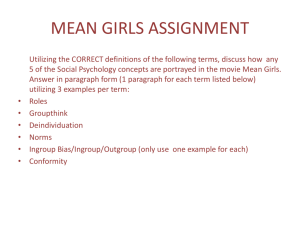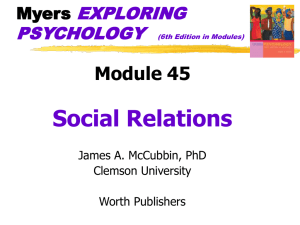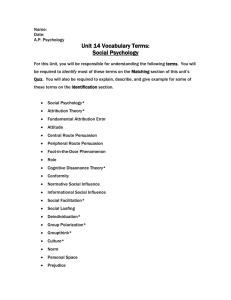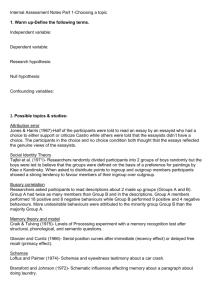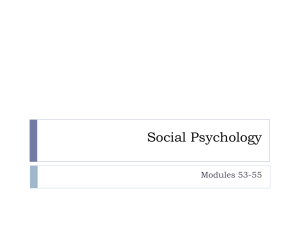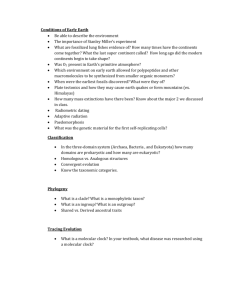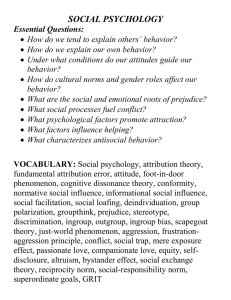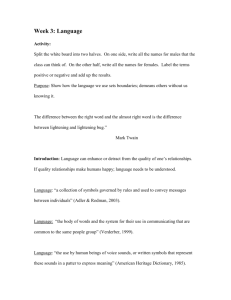The Power of Shared Experience: Simultaneous Learning
advertisement
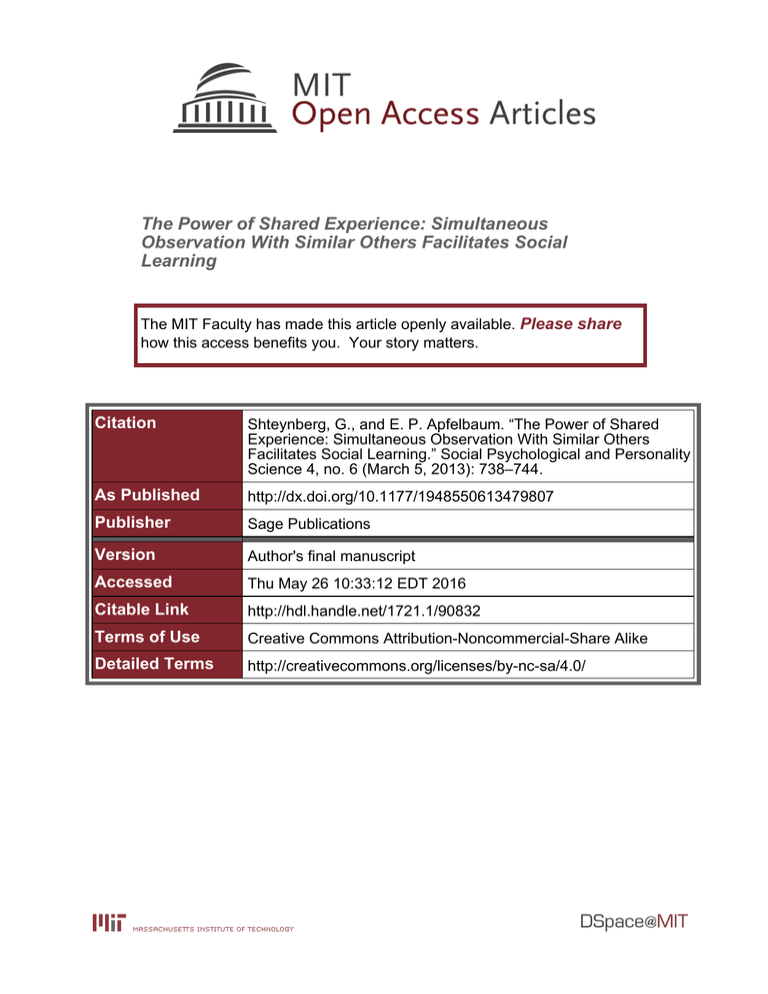
The Power of Shared Experience: Simultaneous Observation With Similar Others Facilitates Social Learning The MIT Faculty has made this article openly available. Please share how this access benefits you. Your story matters. Citation Shteynberg, G., and E. P. Apfelbaum. “The Power of Shared Experience: Simultaneous Observation With Similar Others Facilitates Social Learning.” Social Psychological and Personality Science 4, no. 6 (March 5, 2013): 738–744. As Published http://dx.doi.org/10.1177/1948550613479807 Publisher Sage Publications Version Author's final manuscript Accessed Thu May 26 10:33:12 EDT 2016 Citable Link http://hdl.handle.net/1721.1/90832 Terms of Use Creative Commons Attribution-Noncommercial-Share Alike Detailed Terms http://creativecommons.org/licenses/by-nc-sa/4.0/ Shared Experience The Power of Shared Ingroup Attention: Simultaneous Observation with Similar Others Facilitates Social Learning Garriy Shteynberg University of Tennessee Evan P. Apfelbaum Massachusetts Institute of Technology In Press at Social Psychological and Personality Science Abstract: 141 Word count: 3351 1 Shared Experience 2 Abstract Across disciplines, social learning research has been unified by the principle that people learn new behaviors to the extent that they identify with the actor modeling them. We propose that this conceptualization may overlook the power of the interpersonal situation in which the modeled behavior is observed. Specifically, we predict that contexts characterized by shared ingroup attention are particularly conducive to social learning. In two studies, participants were shown the same written exchange in either paragraph or chat form across multiple interpersonal contexts. We gauged social learning based on participants’ tendency to imitate the form of the written exchange to which they were exposed. Across both studies, results reveal that imitation is especially likely among individuals placed in the specific context of simultaneous observation with a similar other. These findings suggest that shared ingroup attention is uniquely adaptive for social learning. Shared Experience 3 Social learning is a fundamental process by which individuals, groups, and institutions adopt new behaviors (Boyd, Richerson, & Henrich, 2011). From psychology and communication to organizational behavior and criminology, social learning research has been unified by the principle that “most human behavior is learned observationally through modeling” (p. 22) based on the degree to which people identify with the actor modeling a behavior (Bandura, 1977). We propose that this classic conceptualization of observational learning may underestimate the power of the interpersonal situation in which new behaviors are observed; namely, contexts characterized by shared ingroup attention: the simultaneous observation of a behavior with a member of one’s social group. Why is Shared Ingroup Attention Important? Faced with limited processing and memory resources (Broadbent, 1958; Miller, 1956), individuals are constantly under pressure to prioritize their use of cognitive resources so as to focus on the most important information in their environment. While the importance of information may be signaled by a variety of factors, recent theoretical and empirical work suggest that individuals’ cognitive resources are particularly likely to be devoted to information that is co-attended with their group members (Eskenazi, Doerrfeld, Logan, Knoblich, & Sebanz, 2012; He, Lever, & Humphreys, 2011; Shteynberg, 2010; Shteynberg & Galinsky, 2011; Shteynberg, Hirsh, Galinsky & Knight, in press). Research indicates that, beginning as early as 4 months of age, objects that are jointly attended to by infants and their caregivers are more deeply encoded and are better recognized than are objects that infants attend to alone (Baron-Cohen, 1995; Bruner, Shared Experience 4 1983; Reid, Striano, Kaufman, & Johnson, 2004; Tomasello, 1999; Tomasello, Carpenter, Call, Behne, & Moll, 2005). Indeed, there is evidence that this propensity for infants to take greater notice of information co-attended with their caregiver is critical to understanding language development. Infants’ orienting to the attentional habits of their caregivers has been found to be an important antecedent of language ability (Carpenter, Nagell & Tomasello, 1998) and infant vocabulary (Morales et al., 1998). Also, previous work has found that autistic children with learning disabilities are less inclined to exhibit joint attention with others (Leekam, Lopez & Moore, 2000). There is also evidence that shared ingroup attention remains important into adulthood; namely, adults are more likely to engage in elaborative processing of an object, or encode information in relation to a broader range of existing knowledge structures (Craik & Tulving, 1975), when that object is believed to be co-attended with one’s social group (Shteynberg et al., 2012). For example, recent work has indicated that objects that are the target of shared ingroup attention are described with greater verbal complexity (Shteynberg et al., 2012) and are better remembered (Eskenazi, Doerrfeld, Logan, Knoblich, & Sebanz, 2012; He, Lever, & Humphreys, 2011; Shteynberg, 2010) than objects attended to in other contexts. Related work has shown that shared ingroup attention can also intensify the pursuit of jointly attended goals (Shteynberg & Galinsky, 2011). Together, this work suggests that shared ingroup attention heightens elaborative processing of co-attended objects—an effect that emerges even in contexts for which the co-attention of others is merely assumed, such as online settings (e.g., Shteynberg et al., in press). Shared Experience 5 Why Would Shared Ingroup Attention Facilitate Social Learning? The ability to experience the world from a shared perspective has been theorized to be a biologically primitive adaptation that gave humans an unprecedented capacity for collective coordination and behavior (Seale, 1995; Tomasello, 1999). Moreover, to the extent that human genetic survival relied on successful within-group coordination and collective action (Kesebir, 2011; Wilson & Wilson, 2007), the capacity to quickly shift cognitive resources to information that is co-attended with one’s social group may have conferred a critical evolutionary advantage. For instance, if Group Members A and B devote greater cognitive resources to co-attended information (as compared to uniquely attended information), it then follows that Group Members A and B will attain greater overlap in their mental models of their environment, which would likely facilitate future social coordination and cooperation. Indeed, it is possible that humans have an evolved joint attention mechanism (Baron-Cohen, 1995), which diverts cognitive resources to information that is thought to be co-attended with one’s social group (Shteynberg, 2010). This interpretation suggests the identity of co-attending others is critical, given that attaining greater overlap in mental models with out-group members, with whom future cooperation is less likely, would confer relatively little adaptive advantage. In sum, previous work indicates that the object of shared ingroup attention may carry particular relevance for individuals because of the likelihood that the object will serve as an axis of future discussion, social coordination or collective action with ingroup members. Here, we explore the possibility that shared ingroup attention influences social learning. Specifically, we test a fundamental question raised by the emerging literature on the psychological consequences of shared ingroup attention: Are interpersonal contexts Shared Experience 6 characterized by co-attention with an ingroup member uniquely adaptive for social learning? While recent research suggests that shared ingroup attention increases elaborative processing of objects, no empirical work has examined whether shared ingroup attention promotes social learning – the actual reproduction of an observed behavior. Establishing a link between shared ingroup attention and social learning would represent a potentially crucial step toward elucidating the social conditions of behavioral change. Experiment 1 In Experiment 1, we examine the hypothesis that contexts characterized by a similar (versus different) other observing the same (versus different) behavior are particularly conducive to social learning. To assess social learning, we expose participants to a written exchange of identical content in either paragraph or chat form across a variety of social contexts. A striking difference between the chat and paragraph format is the presence of line breaks, with the chat format having almost three times the number of line breaks as compared to the paragraph format. As such, we gauged social learning based on participants’ tendency to use more line breaks in their own writing after being exposed to the chat format as compared to the paragraph format. Method and Design. Participants (N=316; 56.3% female; Mage=34.18, SD=11.44) were recruited from an online subject pool to engage in a virtual focus group in which they would be asked about their experiences and opinions on a variety of topics. Participants were randomly assigned to one of four social learning contexts (described below) in which they were presented with a written exchange between two individuals in chat or paragraph form, constituting a 4×2 between-subjects design. Shared Experience 7 Procedure. After providing consent, participants were asked to select one of six animal avatars to represent themselves in an online environment (see Appendix A). They then learned that another participant had chosen an avatar that was a member of the same (or different) category and would observe the same (or different) written exchange. In all, the above manipulations yielded four social learning contexts: (1) shared ingroup attention or observing the same written exchange that a similar other observes (similarother/same-exchange), (2) observing the same written exchange that a different other observes (different-other/same-exchange), (3) observing a different written exchange than a similar other observes (similar-other/different-exchange), and (4) observing a different written exchange than a different other observes (different-other/differentexchange). These manipulations were reinforced by asking the participant to confirm their avatar choice on a subsequent screen, while being exposed to the avatar choice of the other participant. Participants were also asked to confirm whether they would be looking at the same or a different written exchange. This experimental paradigm has been carefully developed through the course of previous work to include several programming features that reliably enhance experimental realism (e.g., intermittent delays and “wait for the other participant” messages; Shteynberg, 2010; Shteynberg & Galinsky, 2011). Once in a social context, participants were presented with a written exchange wherein two engineers brainstorm an innovative automobile technology. Some participants viewed the exchange in chat form, written in a fragmented structure such that each new thought or idea was successively introduced on a separate line. Other Shared Experience 8 participants viewed the exchange in paragraph form. The content of the exchange was identical across conditions. After viewing the exchange, participants were asked to write an unrelated passage on how to improve a common shopping cart. Participants expected that their ideas for shopping cart improvement would be sent to the other participant and that the other participant would send their own ideas in return. Hence, participants across all conditions expected future social interaction. Last, participants indicated their level of motivation, competitiveness with the other participant, and their enjoyment of the study. The passage participants wrote was then coded for evidence of imitation based on the frequency of line breaks in participants’ writing (number of breaks/total character number). We expected that participants who observed the chat (as compared to paragraph) format with a similar other would use more line breaks in their subsequent writing than participants in the other three social contexts. That is, we hypothesized that participants would be particularly likely to imitate the format of the exchange in the shared observation with a similar other condition as compared to all three other conditions. Results and Discussion. To test this hypothesis, we conducted a planned interaction contrast that compared the effect of the exchange format on line break use in the shared observation with a similar other condition versus the effect of the exchange format on line break use in the other three conditions. As illustrated in Figure 1, this test revealed a significant interaction, F(1, 312)=6.73, p=.01. The format of the written exchange influenced the use of line breaks in the predicted direction within the similarother/same-exchange condition, t(308)=2.70, p=.007, such that participants exposed to Shared Experience 9 the chat format used significantly more line breaks than participants exposed to the paragraph format. However, chat versus paragraph format did not influence line break use within the different-other/same-exchange (p=.49), the similar-other/differentexchange (p=.90), or the different-other/different-exchange conditions (p=.51). In sum, these results support the hypothesized link between shared ingroup attention and social learning. Notable as well, participants in the similar-other/simultaneous-exchange condition did not report greater motivation (p=.54), competitiveness with the other participant (p=.17), or enjoyment of the study (p=.86) as compared to participants in the other conditions. Thus, it seems unlikely that the observed difference in behavior in the similarother/simultaneous-exchange condition was driven by greater effort or a heightened sense of engagement. Experiment 2 The results of Experiment 1 indicate that the propensity to imitate the format of the exchange only occurred when participants thought that they were observing the exchange with a similar other, suggesting settings characterized by shared ingroup attention may be uniquely adaptive for social learning. Still unclear, however, is whether the simultaneity of shared observation was a necessary component of the effect. Given that social situations are often highly dynamic, with novel information arriving in rapid succession, prioritizing information that is simultaneously co-attended with one’s social group may be of vital importance to achieving social coordination. That is, it may be that knowing the attentional behavior of an ingroup member in the here-and-now is the most accurate indicator of that individual’s current state and intentions for future action. For Shared Experience 10 example, if Group Member A prioritizes information that Group Member B attended to in the past, Group Member A’s mental model of the environment may fall out of step with Group Member B’s mental model, potentially compromising social coordination. Furthermore, the knowledge that Group Member B is not simultaneously co-attending to the same information may signal to Group Member A that Group Member B’s attention is presently directed elsewhere. As such, Group Member A may shift cognitive resources to search for present targets of co-attention with Group Member B or others. In Experiment 2, we examine this logic by directly testing whether the simultaneity of observation is necessary to yield the effect of shared ingroup attention. Method and Design. As in Experiment 1, participants (N=314; 62.1% female; Mage=33.27, SD=11.39) were recruited from an online subject pool to engage in a virtual focus group. Participants were randomly assigned to one of four social learning contexts (described below) in which they were presented with the same written exchange between two individuals in chat or paragraph form, constituting a 4×2 between-subjects design. Procedure. Mirroring the procedure of Experiment 1, after providing consent, participants were asked to select one of six animal avatars to represent themselves. In contrast, however, in three of the conditions, they then learned that the other participant had chosen an avatar that was a member of the same category as the one they chose. In these conditions, participants were either told that they would (1) simultaneously observe the same written exchange as the similar other, (2) observe the same written exchange as the similar other after the other participant had done so, or (3) observe the same written exchange as the similar other before the other participant would do so. In the fourth condition, participants were informed that they would complete the study alone and there Shared Experience 11 was no mention of another participant. These manipulations were reinforced by asking participants to confirm their avatar choice on a subsequent screen, while being exposed to the avatar choice of the other participant. Participants were also asked to confirm whether they would be observing with, after, or before the other participant. In all, this yielded four social learning contexts: (1) simultaneously observing the same written exchange that a similar other observes (similar-other/simultaneousobservation), (2) observing the same written exchange after a similar other observes it (similar-other/post-observation), (3) observing the same written exchange before a similar other observes it (similar-other/pre-observation), and (4) observing the exchange alone (alone). As in Experiment 1, after viewing the exchange, participants were asked to write an unrelated passage on how to improve a common shopping cart that would ostensibly be sent to the other participant. Participants then indicated their level of motivation, competitiveness with the other participant, and their enjoyment of the study. As in Experiment 1, our analysis focused on the frequency of line breaks in participants’ own writing (number of breaks/total character number) as a measure of the degree to which the social contexts facilitated imitation. Results and Discussion. We conducted a planned interaction contrast that assessed the effect of exchange format on line break use in the simultaneous observation with a similar other condition as compared to the other three conditions. Replicating the pattern of results in Experiment 1, this analysis revealed a significant interaction, F(1, 310)=5.56, p=.019. As predicted, the format of the written exchange influenced participants’ use of line breaks within the similar-other/simultaneous-observation Shared Experience 12 condition, t(306)=2.36, p=.019, such that participants exposed to the chat format used significantly more line breaks than participants exposed to the paragraph format. However, chat versus paragraph format did not influence line break use within the similar-other/post-observation (p=.25), the similar-other/pre-observation (p=.86), or the alone conditions (p=.91). Finally, participants in the similar-other/simultaneous-exchange condition did not report greater motivation (p=.24), competitiveness with the other participant (p=.31), or enjoyment of the study (p=.25) as compared to the participants in the other conditions. Across two studies, our results support the general notion that contexts characterized by shared ingroup attention are particularly conducive to social learning. Specifically, we demonstrated that shared observation with a similar other heightened subsequent imitation of the observed written exchange. Moreover, the perceived simultaneity of such observation appears to be essential to obtaining this increase in imitation. Of central theoretical importance, these findings are difficult to understand through the lens of traditional models of behavioral imitation alone (i.e., Social Learning Theory). That is, if the learning effect were a result of participants’ tendency to imitate the writing behavior being modeled, then greater learning should have occurred across all conditions. Moreover, if the learning effect were a consequence of participants’ tendency to imitate the assumed behavior of a similar other, then greater learning should have occurred in the similar-other/post-observation and similar-other/pre-observation conditions. Yet neither of these was the case. There were also no differences in reported levels of motivation, competitiveness, or enjoyment across social context conditions, Shared Experience 13 suggesting that the learning effect seems unlikely to be the result of greater general effort or engagement. One noteworthy element of the results, as evidenced from comparison of simultaneous observation with a similar other conditions in Figures 1 and 2, is that the learning effect appears to be driven more so by the chat format in Experiment 1, and by the paragraph format in Experiment 2. For a more powerful test of learning within the chat versus paragraph conditions, we combined data from both studies yielding a dataset of 630 participants. Testing the simple effect of the key social context within the chat and paragraph format conditions showed that participants simultaneously observing with a similar other exhibited greater learning within both the chat, t(616)=2.92, p=.004, and paragraph, t(616)=2.07, p=.039, formats as compared to the control social contexts. The fact that greater learning was not confined to the chat or paragraph condition alone suggests that the learning effect is not dependent on the idiosyncrasies of one particular format; thus, lending additional support to the relationship between shared ingroup attention and social learning. One fascinating question raised by our findings is whether or not participants were consciously aware of their tendency to imitate the modeled writing behavior. Given the null effects on self-reported measures of engagement and the subtle nature of the writing format manipulations, it seems unlikely that participants were aware that they were more likely to imitate due to shared ingroup attention. Indeed, one possibility is that the relationship between shared ingroup attention and social learning is implicit, governed by a fast and frugal heuristic that operates outside participants’ awareness Shared Experience 14 (Gigerenzer, 2004) – if shared ingroup attention is perceived, greater learning is activated. This remains an important question for future study. It is also important to consider whether the expectation of future interaction with the co-attending other is a necessary precondition to greater social learning. This conclusion is consistent with the results of our study and the more general logic that shared ingroup attention provides an adaptive advantage because it enhances future social coordination among group members. Nonetheless, it is also possible that the effect of shared in group attention on social learning would persist even when future social interaction is not explicitly highlighted. If, as we theorize, the power of shared ingroup attention evolved as an adaptation to facilitate human survival—at a time in which survival was highly dependent on cooperation in small groups (Boehm, 2002; Bowles & Gintis, 2003) with who subsequent interaction was all but guaranteed—it may be that the prospect of future group interaction need not be specified explicitly. In short, it remains an open question as to whether expectation of future interaction is a necessary precondition to trigger social learning. Finally, it is interesting to consider our findings as they relate to research on behavioral mimicry (Chartrand & Bargh, 1999). Although behavioral mimicry research typically involves face-to-face interaction, which did not occur in our studies, it is notable that behavioral imitation of the modeled writing behavior did not occur across the board, but only in the context of shared ingroup attention. From a behavioral mimicry perspective, one explanation for this relatively focused effect is that participants did not sufficiently identify with or relate to the engineers modeling the writing behavior (Lakin, Jefferis, Cheng, & Chartrand, 2003). It is also possible that the nature of one’s social Shared Experience 15 context moderates the effect of behavioral mimicry such that mimicry is most robust when the target behavior is not only exhibited by a fellow ingroup member, but also, is co-attended with that individual. Conclusion. In all, the reported effects of shared ingroup attention may contribute one piece of the puzzle toward understanding humans’ extraordinary capacity for social learning. Our findings also imply that the psychological power of co-experienced mass and social media may reside, in part, in their ability to supply their audiences with the experience of shared ingroup attention. Investigating this interpretation certainly requires additional research, but, to our knowledge, these studies are among the first to raise this possibility. In closing, social learning appears to be activated not only as a function of who models new behaviors, but also with whom these experiences are simultaneously shared. Shared Experience 16 References Bandura, A. (1977). Social learning theory. Englewood Cliffs, NJ: Prentice Hall. Baron-Cohen, S. (1995). Mindblindness: An essay on autism and theory of mind. Cambridge, MA: MIT Press. Boehm, C. (2002). Variance reduction and the evolution of social control. Department of Anthropology, USC. Bowles, S., & Gintis, H. (2003). Origins of human cooperation. Genetic and cultural evolution of cooperation, 429–43. Boyd, R., Richerson, P. J., & Henrich, J. (2011). The cultural niche: Why social learning is essential for human adaptation. Proceedings of the National Academy of Sciences (USA), 108, 10918–10925. Broadbent, D. (1958). Perception and communication. London, England: Pergamon Press. Bruner, J. (1983). Child’s talk: Learning to use language. New York: Norton. Carpenter, M., Nagell, K., & Tomasello, M. (1998). Social cognition, joint attention, and communicative competence from 9 to 15 months of age. Monographs of the Society for Research in Child Development, 4, 176. Chartrand, T. L., & Bargh, J. A. (1999). The chameleon effect: The perception–behavior link and social interaction. Journal of Personality and Social Psychology, 76(6), 893–910. doi:10.1037/0022-3514.76.6.893 Craik, F. I. M., & Tulving, E. (1975). Depth of processing and the retention of words in episodic memory. Journal of Experimental Psychology: General, 104, 268-294. Eskenazi, T., Doerrfeld, A., Logan, G. D., Knoblich, G., & Sebanz, N. (2012). Your Shared Experience 17 words are my words: Effects of acting together on encoding. The Quarterly Journal of Experimental Psychology, DOI:10.1080/17470218.2012.725058 Gigerenzer, G. (2004). Fast and frugal heuristics: The tools of bounded rationality. In D. D. Koehler & N. Harvey (Eds.), Blackwell handbook of judgment and decision making (pp. 62-88). Oxford, England: Blackwell. He, X., Lever, A. G., & Humphreys, G. W. (2011). Interpersonal memory-based guidance of attention is reduced for ingroup members. Experimental Brain Research, 211(3-4), 429-438. Lakin, J. L., Jefferis, V. E., Cheng, C. M., & Chartrand, T. L. (2003). The Chameleon Effect as Social Glue: Evidence for the Evolutionary Significance of Nonconscious Mimicry. Journal of Nonverbal Behavior, 27(3), 145–162. doi:10.1023/A:1025389814290 Leekam, S.R., Lopez, B., & Moore, C. (2000). Attention and joint attention in preschool children with autism. Developmental Psychology, 2, 261-273. Miller, A. G. (1956). The magical number seven, plus or minus two. Psychological Review, 2, 81–97. Morales, M., Mundy, P., Delgado, C.E.F., Yale, M., Messinger, D., Neal, R., Schwartz, H.K. (2000). Responding to joint attention across the 6- through 24-month age period and early language acquisition. Journal of Applied Developmental Psychology, 3, 283-384. Reid, V. M., Striano, T., Kaufman, J., & Johnson, M. H. (2004). Eye gaze cueing facilitates neural processing of objects in 4-month-old infants. NeuroReport, 15(16). Shared Experience 18 Shteynberg, G. (2010). A silent emergence of culture: The social tuning effect. Journal of Personality and Social Psychology, 99(4), 683-689. Shteynberg, G., & Galinsky, A. D. (2011). Implicit coordination: Sharing goals with similar others intensifies goal pursuit. Journal of Experimental Social Psychology, 47, 1291-1294. Shteynberg, G., Hirsh, J. B., Galinsky, A. D., & Knight, A., P. (in press). Shared attention increases mood infusion. Journal of Experimental Psychology: General. Accepted. Tomasello, M. (1999). The Cultural Origins of Human Cognition. Boston: Harvard University Press. Tomasello, M., Carpenter, M., Call, J., Behne, T., & Moll, H. (2005). Understanding and sharing intentions: The origins of cultural cognition. Behavioral and Brain Sciences, 28, 675 – 691. Wilson, D. S., & Wilson, E. O. (2007). Rethinking the theoretical foundation of sociobiology. Quarterly Review of Biology, 82, 327–348. Shared Experience Figure 1. Social Context by Exchange Format on % of Line Breaks (Experiment 1) 19 Shared Experience Figure 2. Social Context by Exchange Format on % of Line Breaks (Experiment 2). 20 Shared Experience Appendix A. The Online Environment. Avatar choice at the beginning of the Experiment: 21
